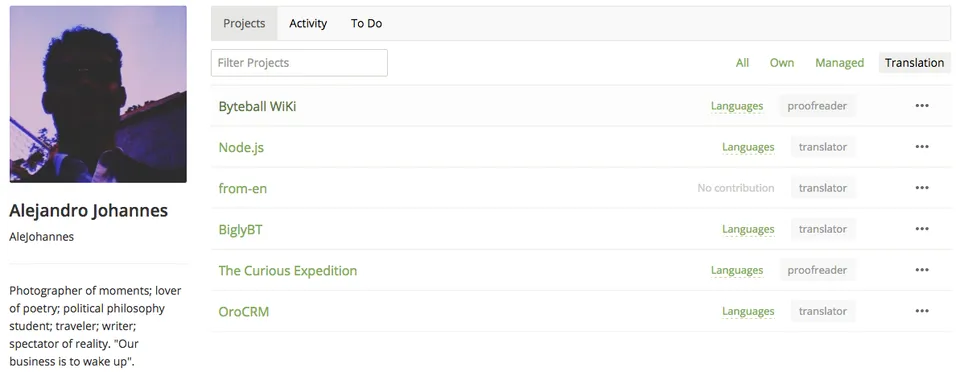Github Repository
https://github.com/nodejs/i18n
Project Details
By definition, Node.js is a Java Runtime Environment (JRE). But it is more than just that. While common JREs serve as machine backups that allow users to smoothly run JavaScript on their browsers and applications, this open-source project functions as an app that manages Java code by itself. It's practical uses for developers are endless. It grants an extraordinarily versatile platform for designing code, programs, websites and other applications. And that isn't all: Node provides a virtual facility for testing the proper work of Java-driven programs and devices –and their planned updates–, helping to find bugs, solve errors, fix code and vastly improving their performance.
I believe all the amazing uses of Node are to be considered by themselves and I declare myself a fan of the project. But, besides, I support it for its working properties as a medium for bringing to reality countless creations that can be as good as Node itself. Imagination (and Java) is the limit! The open translation of Node to thirty-three (33) languages proves the advantages of open-source projects when it comes to diversification of knowledge and worldwide spreading of useful tools.
Ahead, there is the link of the program's webpage:
Contribution Specifications
Translation Overview
This is my 15th contribution to Node.js as a translator. For this collaboration, I continued my previous work on CHANGELOGS_ARCHIVE.md file, translating Node's changelogs of versions between 0.1.33 and 0.1.17.
A changelog is a registry of all the changes made on determined project for each one of its versions. The files created for such purpose list modifications on internal components, substitutions of protocols, updates, deprecations, addition of supported programs, new functions, corrected errors and fixed bugs. To sum up: every single feature that started being applied in each version must be specified and described in this registry. The objective of that is providing a timeline of the development of the project and, by doing so, helping programmers to check any detail they need to understand the way it came to be what it is and make it better in the future.
I can refer to one of the logs I translated to illustrate the dynamics of the changelog. This one is from Version 0.3.1:
- "Module system refactor"
To understand this entry, there are three concepts that need to be addressed. Each one has a technical significance in the fields of informatics and computing-science that differs from the common (non-technical) language.
The first one is Module. Modules are virtual compilations of functions and tools that manage particular tasks within a software. They are interchangeable, independent one from another and can be updated (adding, modifying or removing some of its elements) without affecting the integrity of the software. Although their functionality is theoretically unaffected by the contents of other modules, they recognize them and are pretty flexible at the time of programming conjoint operations.
This definition takes us to specify what a Module System is. Further than its general definition as the collection of interrelated modules that take part within a software, it is import to know that a Java-oriented module system, named as the Java Platform Module System, was launched in 2017. Its features that can be an extraordinarily asset for Node.js. The Java Platform Module System is a set of modules, associated tools and resources that execute JavaScript code. It started being developed with the Java's JSR 277, back in 2006, and its release was delayed in three occasions... But... After 9 years... The wait finally ended September last year with the launch of Java 9 (with gongs, fireworks and neon lights!).
Last, but not least: a code refactoring (which imperative verbal form is abbreviated here as "refactor") is the execution of a modification in the code of certain program without provoking a noticeable alteration of its external functionality and behavior. Code refactoring is done to make sure there's no useless code within a software and all the processes it conducts are structured the most efficient way possible, saving space, memory and improving the performance of the machine.
Knowing all these concepts, the comprehension of the quoted entry comes easy. A code refactoring was executed on Node.js' module system (its internal one from february 2010, not the Java Platform Module System), cleaning it up, polishing its functions and improving its performance... Summing up: making it better for all users.
You can check some references here for more information about the resources mentioned above:
- https://www.techopedia.com/definition/25972/modular-programming
- https://en.wikipedia.org/wiki/Modular_programming
- https://medium.freecodecamp.org/anatomy-of-js-module-systems-and-building-libraries-fadcd8dbd0e
- https://en.wikipedia.org/wiki/Java_Platform_Module_System
- https://refactoring.com/
- https://en.wikipedia.org/wiki/Code_refactoring
All changes included in each one of the versions of the project are formatted as pull-request commits. Id est, they are presented as very brief comments about the action that was suggested, are normally written with imperative verbs, and have a strict limitation on their number of characters (so even complex ideas are reduced to a small amount of words). These specifications made the translation of this document a challenge. However, it was satisfactorily achieved! As you will see in the examples below, the name of the developer who provided each log is often referred inside parenthesis at the end of it.
Work example #01:
English:
Allow passing env to child process (Isaac Schlueter)
Spanish:
Permitir el paso de ambiente al proceso secundario (Isaac Schlueter)
Work example #02:
English:
Bugfix: Use InstanceTemplate() instead of PrototypeTemplate() for accessor methods. Was causing a crash with Eclipse debugger. (Zoran Tomicic)
Spanish:
Corrección de bug: Utilizar InstanceTemplate() en lugar de PrototypeTemplate() para métodos accesores. Este estaba causando un colapso con el depurador Eclipse. (Zoran Tomicic)
Languages
This translation was made from English to Spanish.
I got plenty experience translating and proofreading this project as an Utopian contributor. I collaborate here as translator and Language Moderator of the Da-Vinci/Utopian Spanish translation team. Besides this project, I have experience translating and proofreading The Curious Expedition, Ancap-ch, Byteball Wiki, OroCrm and BiglyBT.
Word Count
- The amount of words translated in this contribution is: 1090.
- The total amount of words translated in this project (as a Da-vinci/Utopian translator) is: 15429.
Previous Translations of the Project
- Contribution N'01. Submitted on September 13th, 2018.
- Contribution N'02. Submitted on September 15th, 2018.
- Contribution N'03. Submitted on September 17th, 2018.
- Contribution N'04. Submitted on September 19th, 2018.
- Contribution N'05. Submitted on September 21th, 2018.
- Contribution N'06. Submitted on September 22th, 2018.
- Contribution N'07. Submitted on September 23th, 2018.
- Contribution N'08. Submitted on October 1st, 2018.
- Contribution N'09. Submitted on October 8th, 2018.
- Contribution N'10. Submitted on October 14th, 2018.
- Contribution N'11. Submitted on October 15th, 2018.
- Contribution N'12. Submitted on October 18th, 2018.
- Contribution N'13. Submitted on October 21st, 2018.
- Contribution N'14. Submitted on October 24st, 2018.
Proof of Authorship
This translation was made between October 25th and 26th, 2018. You can check the translation record in my Crowdin account [here], the activity on the project's Crowdin [here] and a summary of recent additions to the project [here].


